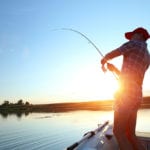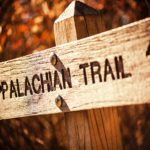Drawing in nearly 3 million visitors each year, the Chattahoochee-Oconee National Forest offers plenty of outdoor activities to enjoy — including hiking, cycling, horseback riding, picnicking, camping, swimming, geocaching, fishing, hunting, scenic driving, and volunteering — stunning mountain scenery to appreciate, and a memorable place to spend quality time with family, friends, and nature in picturesque North Georgia.
Protected by the United States Department of Agriculture’s Forest Service, the Chattahoochee-Oconee National Forest comprises the Chattahoochee National Forest (750k+ acres) in the mountains of North Georgia and the Oconee National Forest (116k+ acres) nestled in eastern Georgia. Together, the Chattahoochee-Oconee National Forest features approximately 867,643 acres of public land to explore!
As one of the largest national forests east of the Mississippi River, the Chattahoochee-Oconee National Forest boasts 850 miles of recreation trails — including the start to the popular 2,190+ mile Appalachian Trail — a wide diversity of wildlife, a rich history, noteworthy sightseeing spots (including Brasstown Bald, Amicalola Falls, and Blood Mountain), and even its own verified Facebook page.
Whether you’re keen to visit areas of the Chattahoochee National Forest or the Oconee National Forest, just remember to follow forest rules and guidelines (by the U.S. Forest Service) put in place for your safety and the safety of our beloved Chattahoochee-Oconee National Forest and its inhabitants. Most importantly, focus on trying new experiences, reconnecting with nature, and making memories to last a lifetime.
History
Originally inhabited and managed by Cherokee and Creek natives, the Chattahoochee and Oconee lands were taken (despite treaty rights) when gold was discovered. Forced along the Trail of Tears in the 1800s, the natives endured as their homes were given away in lotteries.
Due to unregulated logging, gold mining, grazing, hunting, and fishing plus wildfires sparked by trains, skidders, and farms, earlier ecosystems of North Georgia suffered considerably. By the late 1800s and early 1900s, plant and animal species were on the verge of extinction, waterways were damaged, and forests were dwindling…
The Start of the Chattahoochee National Forest
In 1911, the Forest Service purchased 31,000 acres (primarily abandoned farmlands and old homesteads) in Fannin, Union, Gilmer, and Lumpkin Counties — at $7 per acre if you can believe it! Originally part of the Nantahala National Forest in North Carolina and the Cherokee National Forest in Tennessee, the Chattahoochee National Forest was officially established on Sunday, July 9, 1936. Indeed, it was proclaimed a separate national forest by President Franklin D. Roosevelt himself!
Chattahoochee Name
Honoring the area’s first peoples, the Chattahoochee National Forest was named after the Chattahoochee River. Chatta means stone, and ho chee means marked or flowered in a dialect of the Muscogee Creek. English settlers adopted the name from a settlement near Columbus, Georgia, where you could find marked or flowered stones in the Chattahoochee River.
Key Figures
Advisor on the original land purchases and negotiator for further land purchase agreements for the Chattahoochee National Forest, Ranger Roscoe Nicholson (aka Ranger Nick) was the first forest ranger in Georgia. In fact, the Coleman River Scenic Area — where the Coleman and Tallulah Rivers join in the Chattooga River District — was dedicated to Ranger Nick after 40 years of public service.
Promoting conservation, Ranger Arthur Woody (aka Barefoot Ranger) contributed greatly to the wildlife of the Chattahoochee National Forest, namely bringing back trout and deer populations. Trout were shipped to Gainesville and painstakingly driven across backroads through the mountains to be released in streams. Ranger Woody even bought fawns with his personal funds, cared for them, and released them into what would become the Blue Ridge Wildlife Management Area.
Dedicated to Woody’s conservation efforts are many landmarks within the Chattahoochee National Forest that bear his name. Sosebee Cove, 175 acres of prized hardwood along GA 180 negotiated for purchase by Woody, is specifically set aside as a memorial to this legendary ranger from North Georgia.
The Start of the Oconee National Forest
President Dwight D. Eisenhower proclaimed 96,000 acres of federal lands to be established as the Oconee National Forest on Friday, November 27, 1959. Around the same time, the Oconee joined the Chattahoochee to become known as the Chattahoochee-Oconee National Forests we know and love today.
Wildlife
Restoration and conservation efforts over the years, including planting trees, fighting wildfires, monitoring erosion, and reintroducing species, have contributed to much healthier ecosystems within the Chattahoochee-Oconee National Forest.
Today, there are tons of plants, wildflowers, and animals — from mammals and birds to fish and amphibians — to spot while exploring! That being said, there are 29 threatened or endangered species (including plants) that still need our help.
FAQ: Are there bears in the Chattahoochee National Forest? Yep, American black bears call this forest home.
Animals
- Deer
- Foxes
- Coyotes
- American Black Bears
- Bobcats
- Beavers
- River otters
- Weasels
- Squirrels
- Bats
- Turkeys
- Geese
- Hawks
- Eagles
- Ducks
- Sparrows
- Blackbirds
- Owls
- Hummingbirds
- Cardinals
- Rainbow Trout
- Turtles
- Frogs
- Blue Ghost Fireflies
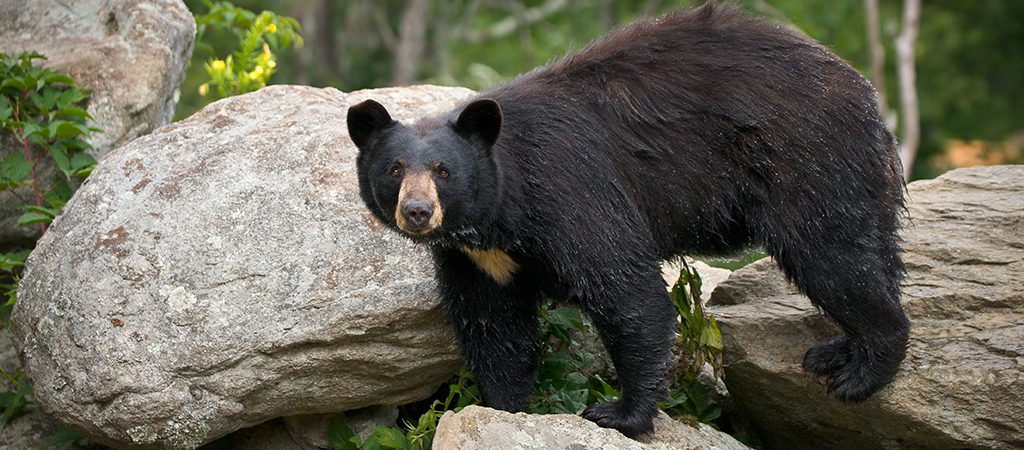
Rivers, Streams, Lakes & Waterfalls
Adding to the natural beauty of the Chattahoochee National Forest are 2,200+ miles of rivers and streams (including 1,367 miles of trout streams) plus gorgeous lakes and waterfalls. Check out the free-flowing Chattooga River, headwaters of the Chattahoochee River, and Georgia’s enchanting Toccoa River that flows northbound.
Spring-fed Lake Conasauga, nestled in the Blue Ridge Mountains, is Georgia’s highest lake at 3,000+ feet above sea level. In the Oconee National Forest, the man-made Lake Sinclair spreads across 15,330 acres and produces hydroelectricity through the Georgia Power Company. Falling from 729 feet along 7 cascades, Amicalola Falls in the Chattahoochee National Forest is Georgia’s tallest cascading waterfall — and it’s breathtaking.
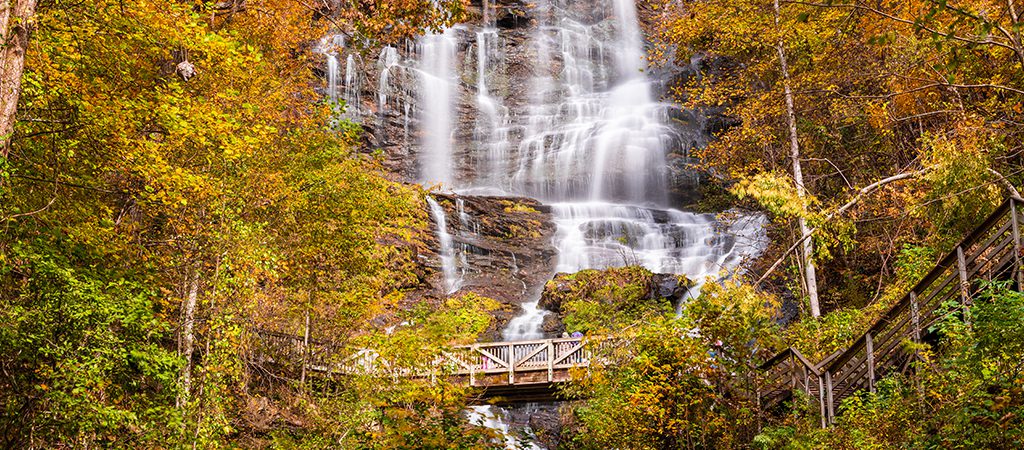
Mountains
Within the boundaries of the Chattahoochee-Oconee National Forest starts the Appalachian Mountain Range that includes the Blue Ridge Mountains, the Piedmont Mountains, and the Armuchee Ridges. Many famous mountain peaks can be seen throughout the Chattahoochee-Oconee National Forest.
Named in honor of local Cherokee John Fields, Johns Mountain in Walker County features an overlook with views of the valleys and mountains beyond. Springer Mountain in Fannin County is the starting point of the Appalachian Trail, and Blood Mountain bordering Lumpkin and Union Counties is Georgia’s tallest peak along the Appalachian Trail.
The western border of the Chattahoochee National Forest is mapped along Taylor Ridge, part of the Armuchee Ridges (low, steep ridges seen west of I-75 near Dalton, GA). As Georgia’s highest peak at a staggering 4,784 feet, Brasstown Bald near Blairsville is also a must-see!
Wildernesses
Monitored and cared for by the USDA Forest Service, 10 wildernesses make up 15% of the Chattahoochee National Forest. Some even stretch into the Cherokee National Forest in Tennessee, the Nantahala National Forest in North Carolina, and the Sumter National Forest in South Carolina.
Wildernesses are parts of federal lands that are undeveloped and kept in their natural states. These are beautiful, untouched areas to explore when you visit the North Georgia mountains.
- Big Frog Wilderness
- Blood Mountain Wilderness
- Brasstown Wilderness
- Cohutta Wilderness
- Ellicott Rock Wilderness
- Mark Trail Wilderness
- Raven Cliffs Wilderness
- Rich Mountain Wilderness
- Southern Nantahala Wilderness
- Tray Mountain Wilderness
Ranger Districts + Georgia Counties
Spread across 27 counties and 4 ranger districts, the protected Chattahoochee-Oconee National Forest makes up a great deal of North Georgia, just north of Atlanta. The Chattahoochee National Forest encompasses the Blue Ridge, Chattooga River, and Conasauga Ranger Districts, while the Oconee Ranger District lies within the Oconee National Forest.
Rabun County in eastern Georgia holds 148,684 acres as the largest portion of the Chattahoochee National Forest. Catoosa County in northwest Georgia comes in as the smallest portion of the Chattahoochee-Oconee National Forest at around 6 acres. Note: acreages are approximate.
Blue Ridge Ranger District — 357,500 Acres
- Dawson County — 6,760 acres
- Fannin County — 106,130 acres
- Gilmer County — 32,285 acres
- Lumpkin County — 57,005 acres
- Towns County — 57,481 acres
- Union County — 97,839 acres
Contact
Blue Ridge Ranger District
2042 Highway 515 West
Blairsville, GA 30512
706.745.6928
Chattooga River Ranger District — 253,988 Acres
- Banks County — 650 acres
- Habersham County — 39,933 acres
- Rabun County — 148,575 acres
- Stephens County — 23,304 acres
- White County — 41,526 acres
Contact
Chattooga River Ranger District
9975 Highway 441 South
Lakemont, GA 30552
706.754.6221
Conasauga Ranger District — 139,462 Acres
- Catoosa County — 6 acres
- Chattooga County — 19,390 acres
- Floyd County — 6,620 acres
- Gilmer County — 23,098 acres
- Gordon County — 8,076 acres
- Murray County — 51,696 acres
- Walker County — 18,844 acres
- Whitfield County — 11,732 acres
Contact
Conasauga Ranger District
3941 Highway 76
Chatsworth, GA 30705
706.695.6736
Oconee Ranger District — 116,392
- Greene County — 26,659 acres
- Jasper County — 30,517 acres
- Jones County — 16,757 acres
- Monroe County — 251 acres
- Morgan County — 308 acres
- Oconee County — 157 acres
- Oglethorpe County — 3,762 acres
- Putnam County — 37, 981 acres
Contact
Oconee Ranger District
1199 Madison Road
Eatonton, GA 31024
706.485.7110
Forest Supervisor’s Office
1755 Cleveland Highway
Gainesville, GA 30501
770.297.3000
Outdoor Recreation
Outdoor fun and recreation for the whole family await in the Chattahoochee-Oconee National Forest that features 37 developed recreation areas — including loads of picnic spots, campgrounds, swim beaches, and overlooks — 850 miles of trails for hiking, biking, and horseback riding plus historic sites, scenic drives, great hunting and fly fishing, plus volunteer opportunities. There are so many things to do in the Chattahoochee-Oconee National Forest!
Recommended by the USDA Forest Service, check out 16 rec areas to visit in the Chattahoochee-Oconee National Forestin North Georgia.
Visitor Centers
There are 2 visitor centers within the Chattahoochee-Oconee National Forest — Brasstown Bald Visitor Information Center in the Blue Ridge Ranger District and the Anna Ruby Falls Recreation Area in the Chattooga River District.
Brasstown Bald Visitor Information Center
Featuring 360 views at the top of Brasstown Bald, 8,000 square feet of exhibits, and video presentations, this visitor center in Hiawassee is a great place to pause and learn about the area. You can see 4 states from the observation deck, and there are telescopes to help you see significant features in the distance. There’s a drinking fountain, flush toilets, and a daily shuttle service to take you up the steep, paved trail. And you can purchase souvenirs at the gift shop near the parking lot!
It’s $5 per person (16+ years of age) to gain entry to the visitor center and day-use area at Brasstown Bald. After hours, it’s only $3. Applicable passes allow free entry.
Open Daily:
10:00 a.m. – 5:00 p.m.
Shuttle Service:
10:00 a.m. – 12:30 p.m. & 1:10 p.m. – 4:30 p.m. (last shuttle departs to the summit)
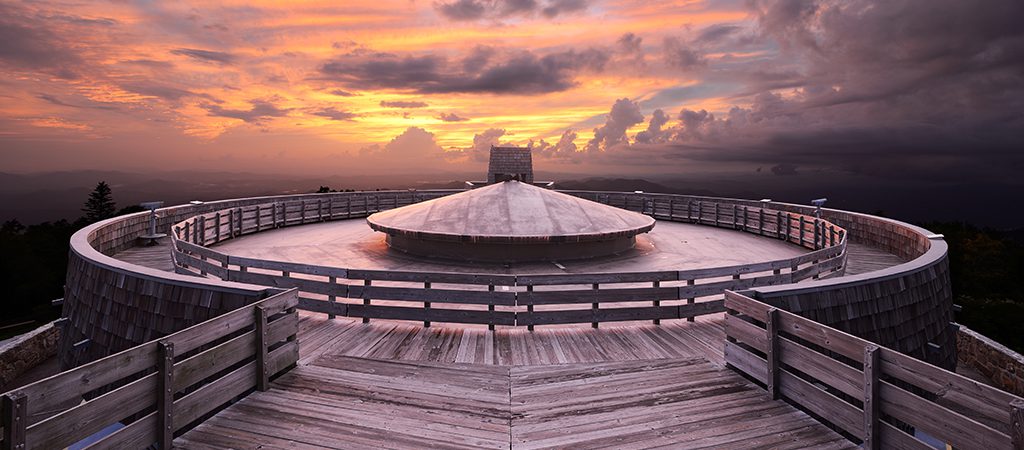
Anna Ruby Falls Visitor Information Center
The Anna Ruby Falls Recreation Area near Helen, GA, is home to this visitor center. There’s ample parking for 90 vehicles, a lovely picnic area to stop for a bite, and a few trails nearby for scenic views. See the twin plunging waterfalls crashing down from 150 feet! The Lion’s Eye Trail boasts paved hiking for the visually impaired with signs in braille and is wheelchair accessible. Restrooms and water fountains are available for visitor use.
It’s $5 per person (16+ years of age) to gain entry to the visitor center at Anna Ruby Falls. Applicable passes allow free entry.
Currently Open:
Thu-Mon, 9:00 a.m. – 5:00 p.m.
(no admission after 4:00 p.m. to reach the falls and back in time for closing)
Regular Hours:
Daily (March 1 – December 31)
9:00 a.m. – 6:00 p.m. (no admission after 5:00 p.m.)
Winter Hours:
Thu-Mon (January 1 – February 28)
9:00 p.m. – 5:00 p.m. (no admission after 4:00 p.m.)
Closed:
Thanksgiving, Christmas Eve & Christmas
Hiking Trails
Experienced and novice hikers will appreciate the 430+ miles of hiking trails in the Chattahoochee-Oconee National Forest. Along with 4 long-distance hiking trails, there are plenty of shorter trails that range from easy to moderate to challenging. No matter which trail you choose, all offer beautiful scenes of nature and chances to spot wildlife. Some hiking trails even lead to stunning waterfalls!
Notably, the Appalachian Trail — the longest hiking-only footpath in the world — starts at the summit of Springer Mountain, spans nearly 79 miles in the Georgia stretch of this 2,190+ mile hike to Maine, and crosses through 5 Chattahoochee wilderness areas.
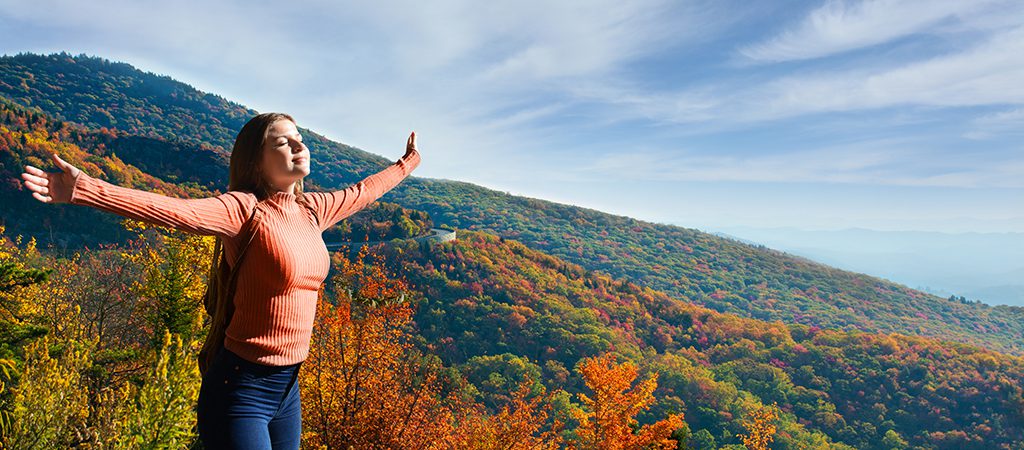
4 Long-Distance Trails
- Appalachian Trail — nearly 79 miles along Georgia stretch
- Bartram Trail — 37 miles
- Benton MacKaye Trail — 53 miles
- Duncan Ridge Trail — 35.5 miles
Popular Hiking Trails
- Amicalola Falls Loop
- Bear Creek Trail
- Blood Mountain Loop
- Chattooga River Trail
- Coosa Backcountry Trail
- Emery Creek Falls Trail
- Grassy Mountain Tower Trail
- High Shoals Falls Trail
- Panther Creek Falls Trail
- Raven Cliff Falls Trail
- Tallulah Gorge Sliding Rock Trail
- Yonah Mountain Trail
Historic Sites
Historic sites can be found along many hiking trails. In fact, there are 4,000+ recorded archaeological sites in the Chattahoochee-Oconee National Forest so far that reach 10,000 years into human history. Track Rock Cap Petroglyph Site in Union County is a neat place that features stone carvings by the original Cherokee and Creek peoples more than 1,000 years ago. And that’s just one of many historic sites in the Chattahoochee-Oconee National Forest!
Pet Friendly?
Are hiking trails in the Chattahoochee-Oconee National Forest pet friendly? Yes, you can bring your dog as long as they are obedient to verbal commands, never wander off, and are kept on a leash in crowded areas.
Horseback Riding
Riding a horse through the trees, across streams, and past scenic overlooks is an excellent way to explore the Chattahoochee-Oconee National Forest. There are plenty of horse-friendly trails to take your riding buddy as well as nearby horse stables that offer trail rides through the national forest. You can even go horse camping around these parts!
Horse-Friendly Trails
- Bull Mountain Trail
- Burgess Mountain Trail
- Iron Mountain Trail
- Kinnard Creek Trail
- Ladyslipper Trail
- Ocmulgee River Trail
- South Fork Trail
- Sumac Creek Trail
- Willis Knob
- Wise Creek Trail
Mountain Biking + ATVs
Cycling through the Chattahoochee-Oconee National Forest offers stunning mountain, wooded, river, and valley scenery as well as a chance to reconnect with nature on a ride. Whether you’re new at cycling or an avid mountain biker, this is the place for you. The national forest contains plenty of cycling trails that range from easy to difficult to suit your level.
Mountain Biking Trails
- Aska Trail System
- Bear Creek Trail
- Bull Mountain Trail
- Iron Mountain Trail
- Mountaintown Creek Trail
- Turner Creek Trail
- Town Creek Bike Trail
- Windy Gap Cycle Trail
Rather take an ATV through the national forest? As long as you stay on designated trails, you’re good to ride! Just beware of cyclists, hikers, and horses, depending on which ATV-approved trail you choose. And remember to check trail reports ahead of time before hauling your ATV into the mountains.
Camping
Primetime camping in North Georgia is found in the Chattahoochee-Oconee National Forest. Boasting 33 campgrounds with around 500 campsites, there are plenty of camping spots to choose from. Backcountry camping is also permitted in certain areas, including near the Chattooga River Trail. Some campgrounds do require reservations for a fee, online or at 1.877.444.6777.
Best Campgrounds
Some of the best campgrounds in the Chattahoochee National Forest include the Tallulah River Campground, the Toccoa River Sandy Bottoms Recreation Area, the Upper Chattahoochee River Campground, the DeSoto Falls Recreation Area, the Dockery Lake Recreation Area, the Low Gap Campground, and the Lake Rabun Beach Recreation Area & Campground…just to name a few!
Important Camping Information
When camping, the USDA Forest Service requires you to make camp in designated spots only and use swimming beaches, day-use areas, and picnic sites between 6:00 a.m. and 10:00 p.m. for safety reasons. Upon leaving, you must always take everything you brought into the national forest back out with you. For groups with more than 5 people, you will need to use a group campsite. And you cannot camp longer than 14 days at a time, which isn’t a problem with a North Georgia cabin rental.
Scenic Drives
One of the best ways to see and experience the Chattahoochee-Oconee National Forest is to take a leisurely scenic drive. It’s a great way to see a lot more in a day, easily bring snacks, snap pics, and spend time with family and friends without breaking a sweat or leaving Grandpa behind.
There are 1,600 miles of roads winding through the Chattahoochee-Oconee National Forest. Some roads close in winter, and motorists are advised to check for road closures year-round on the Forest Service alerts and notices page before piling into the car.
Top Scenic Drives
- Russell-Brasstown National Scenic Byway — 40-mile loop around the headwaters of Chattahoochee River (3 hours)
- The 60/180/129/19 Scenic Loop — 40-mile loop along U.S. and State Highways with scenes of the national forest (3 hours)
- Ridge and Valley Scenic Byway — 51-mile loop along the Armuchee Ridges of the Appalachian Mountains (4 hours)
- Cohutta-Chattahoochee Scenic Byway — 54-mile journey showcasing the Cohutta Mountains and ending at a mountaintop overlook (4 hours)
Fun on the Water
Canoeing, kayaking, tubing, whitewater rafting, and other non-motorized boating are allowed in the Chattahoochee-Oconee National Forest. Motorized boats (not powered by an internal combustion engine) are permitted on most lakes. Some lakes even allow waterskiing!
Canoeing and kayaking are popular on the Oconee River, Chattahoochee River, Toccoa River (access points at Deep Hole and Sandy Bottoms Recreation Areas), and Lake Sinclair. Best for guided rafting trips is the Chattooga Wild and Scenic River.
Swimmers will appreciate 6 swim beaches and several spots to take a dip in the refreshing waters within the Chattahoochee-Oconee National Forest. Favorite areas to swim include Lake Sinclair, Lake Conasauga, Tallulah River, Lake Rabun, and Blue Ridge Lake.
Many swimming areas also feature picnic spots, nearby hiking trails, and campgrounds to make your outdoor experience even more enjoyable. For safety reasons, please remember to swim within designated swimming areas only.
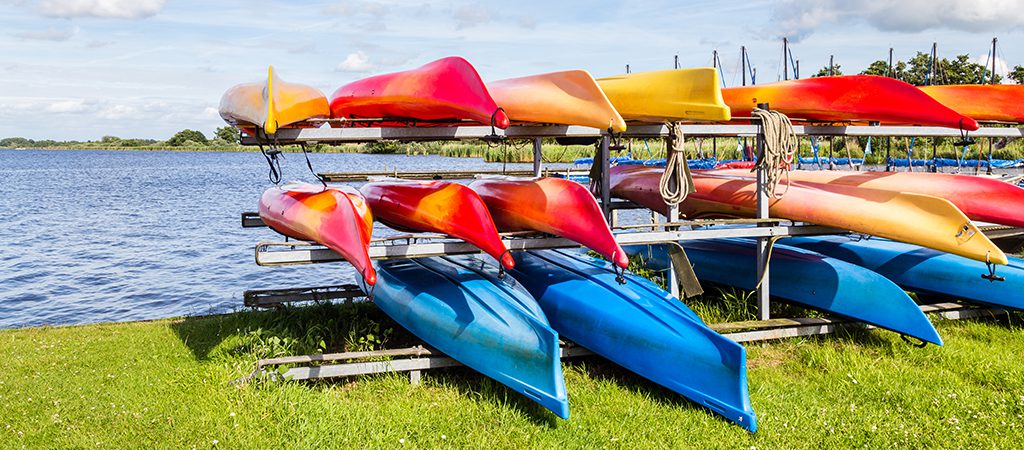
Hunting + Fishing
Hunters and anglers will appreciate a challenge and fun time sporting in the Chattahoochee-Oconee National Forest. Waters are stocked with roughly 525,000 catchable trout annually — namely from the Chattahoochee Forest National Fish Hatchery — to enjoy shoreline or fly fishing. And the national forest offers a wide variety of huntable critters such as deer, feral hogs, and turkey.
The USDA Forest Service works together with the Wildlife Resources Division of the Georgia Department of Natural Resources (DNR) to manage a healthy wildlife population and habitat to ensure hunting and fishing opportunities for you and future generations. As a contribution, you must adhere to seasons, limits, proper licensing, and forest rules — including no alcohol, only hunting/fishing where allowed, and removing tree stands/gear when leaving the area.
Required Licenses
Outdoor sports in the Chattahoochee-Oconee National Forest require the appropriate license for those who are 16+ years of age. Hunters will need a Georgia hunting license plus any specialty Georgia hunting license depending on the type of animal. Fishermen will need a Georgia fishing license plus a trout fishing license. Combo hunting and fishing licenses are also available. All licenses can be purchased through authorized vendors, usually at local outfitters, or the Georgia DNR website.
Know before you go! Entering onto private land is illegal without permission from the landowner. You may pass through along rivers, but you may not fish where both sides of the river are privately owned.
Volunteer Opportunities
“To sustain the health, diversity, and productivity of the nation’s forests and grasslands to meet the needs of present and future generations” — USDA Forest Service Mission Statement
Volunteers are an integral part of taking care of the wildlife, habitats, and ecosystems of the Chattahoochee-Oconee National Forest. On average, the national forest receives 57,000+ volunteer hours annually — worth more than 1.3 million dollars!
If you appreciate all the national forest has to offer, consider taking part in protecting, preserving, and restoring public lands for future generations today. With 20 hours of volunteer work, you can even earn a national forest pass. All ages are welcome to help.
YOUR Help Matters!
Ways to Contribute
- Adopt a campground.
- Clean up the forest.
- Maintain trails.
- Improve fish habitats.
- Remove invasive plants.
- Help with office work.
- Spread the word!
Georgia Cabins for YOU
When visiting the Chattahoochee-Oconee National Forest, you’ll need a home base — a nearby place to bring back all your gear, get some rest, and relax after a long day in the great outdoors. Georgia Cabins for YOU features cabins along the Toccoa River, just minutes from the national forest.
At your North Georgia cabin rental, you can continue outdoor activities at your cabin rental or simply unwind in the rockers with a glass of sweet tea or jar of local moonshine, soak in the steamy hot tub, or read by the cozy fireplace. Additional amenities include games — like pool tables and arcade units — big screen TVs, and grills. Conveniences include fully equipped kitchens, king-size beds, and free high speed Wi-Fi. And that’s not all!
Start planning your outdoor adventure in the Chattahoochee-Oconee National Forest and book your memorable stay at 1.800.580.5524 today.

